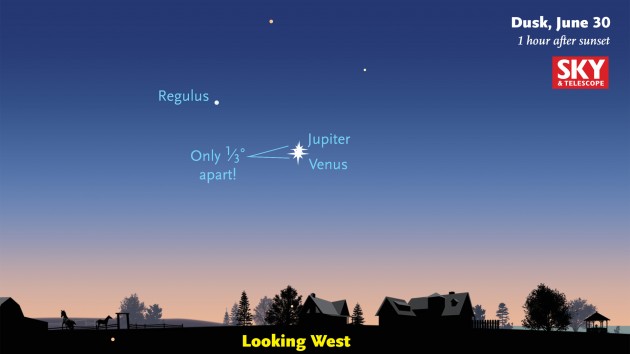- Published: Tuesday, June 23 2015 17:05
Look to the skies on the evening of June 30 or July 1 (depending on your location) over the western horizon just after the sun sets and you will be treated by an amazing sight. Two of the seemly brightest objects in the night sky will meet! Creamy yellow Jupiter will appear right next to bright white Venus only 1/3 of a degree away from each other that they’ll look like a tight, brilliant double star in the evening sky. You’ll be able to cover both with the tip of an outstretched finger.
It's amazing to think that Venus lies just 108 million km away from the Sun and 261 million km away from our planet and is about the same diameter, while giant Jupiter is about 12 times the size of Venus and lies 778 million km away from our star.
 Sky and Telescope diagram
Sky and Telescope diagram
For information, check out the Sky and Telescope website.
Viewing together
Take this opportunity to go out with friends, family or a club! This naked eye event sparks interest in the night sky. It's difficult to miss the meeting of these celestial bodies so why not have a star party to celebrate and take out your scopes and binoculars. At the height of the conjunction, both planets should fit within the field of view of any telescope.
Take photos of your event and of the conjunction and share! We would love to see what you saw in your neck of the woods. Grab a camera and snap some pics and post them on our Members' Report or our Facebook page. We'll share it around the world for you.
Share your knowledge! What a great time to teach what you know about the night sky. Here are some helpful statistics about these planets.
| Venus | Jupiter |
| Radius: 3,760 miles (6,052 km) Distance from Sun: 67,240,000 miles (108,200,000 km) Length of day: 116d 18h 0m Mass: 4.867E24 kg (0.815 Earth mass) Orbital period: 225 days Moons: None Surface Temperature: 462C |
Radius: 43,441 miles (69,911 km) Distance from Sun: 483,800,000 miles (778,500,000 km) Mass: 1.898E27 kg (317.8 Earth mass) Orbital period: 12 years Length of day: 0d 9h 56m Moons: 63 Surface Temperature: -108C |
 Image NASA |
 Image NASA |







